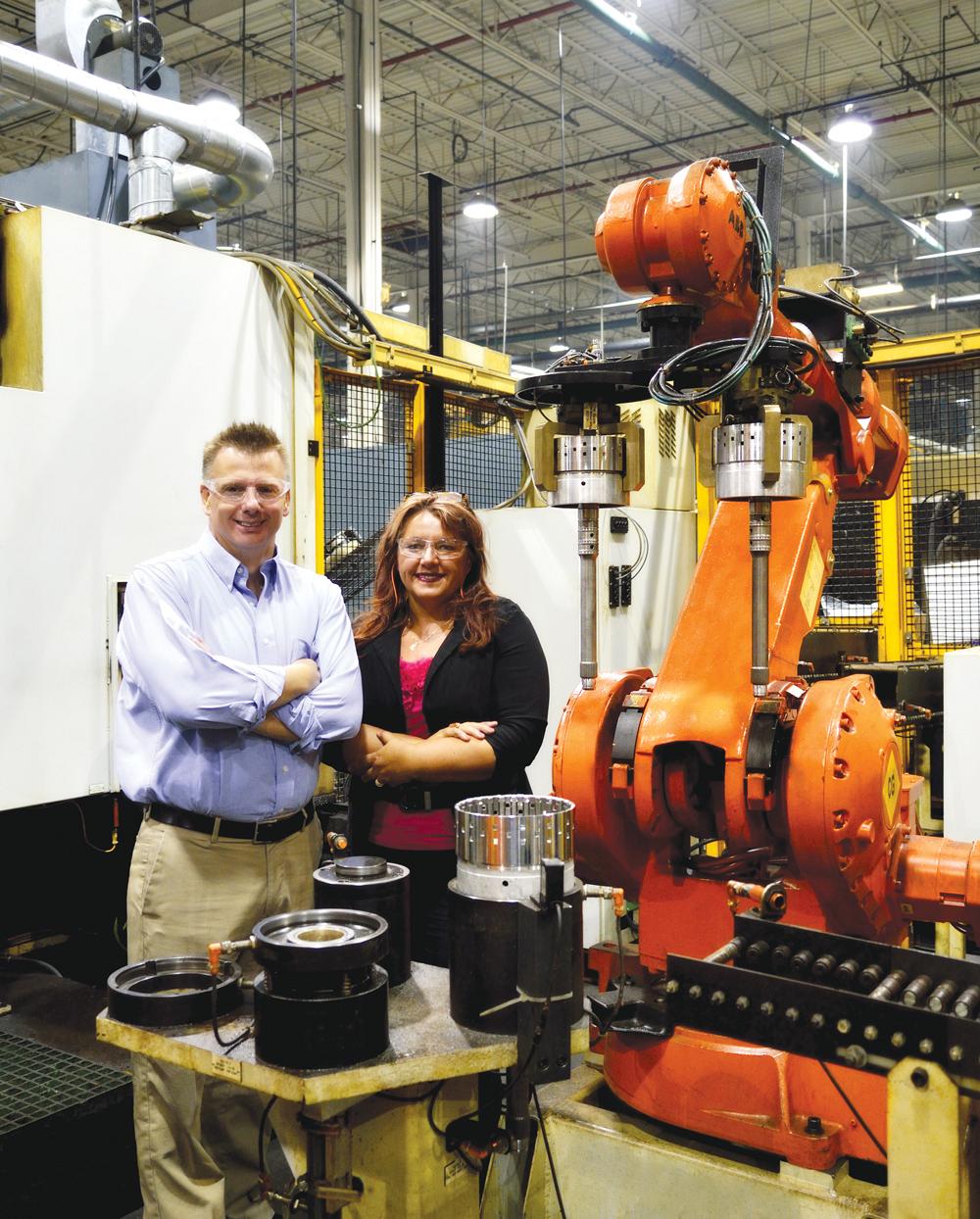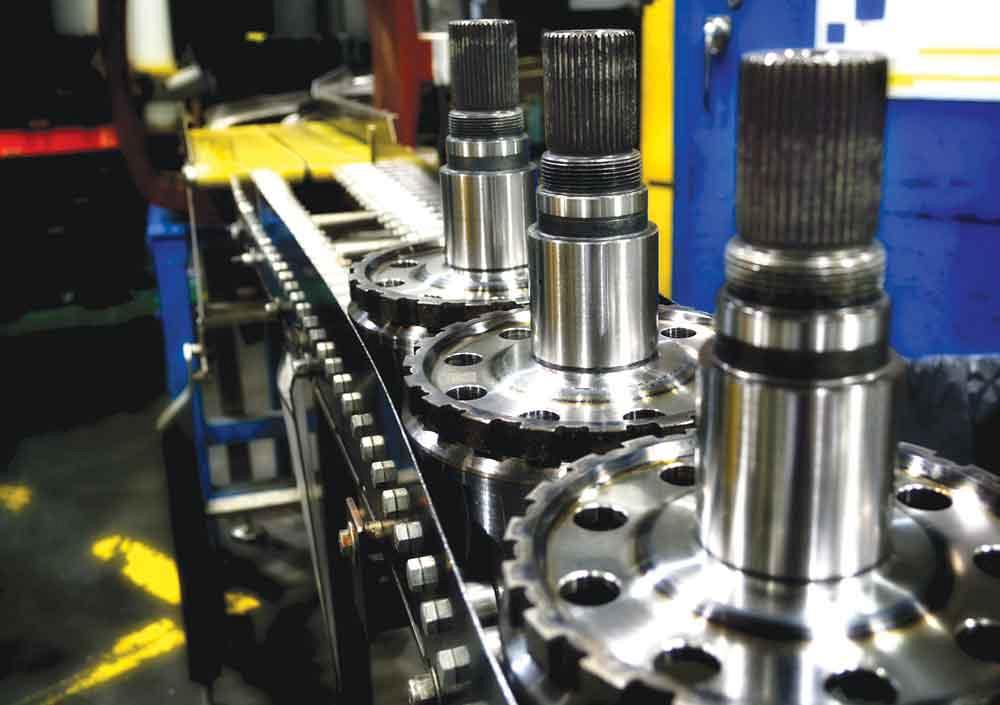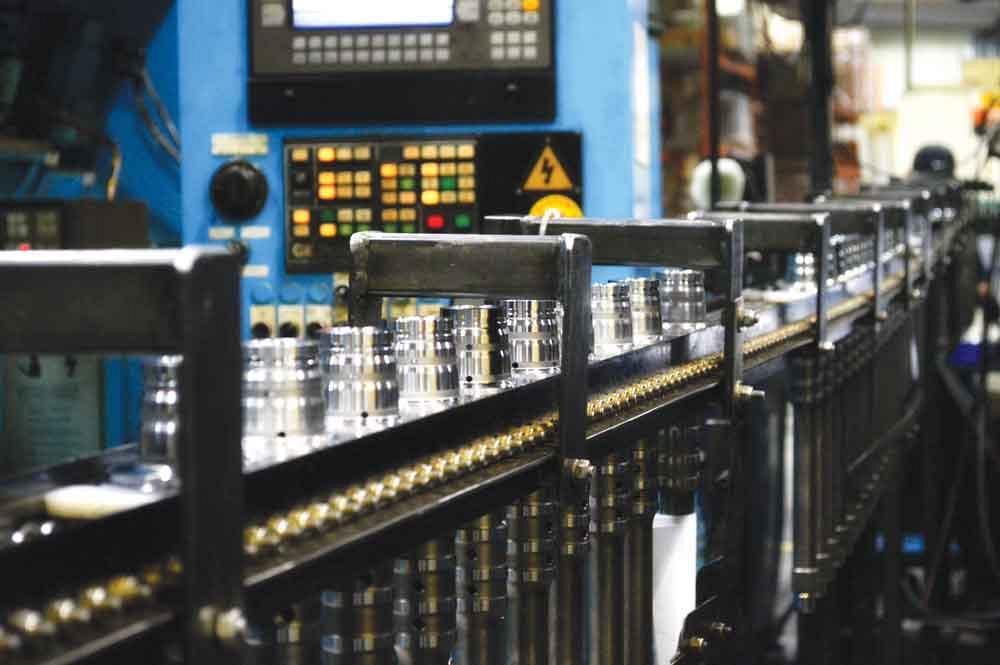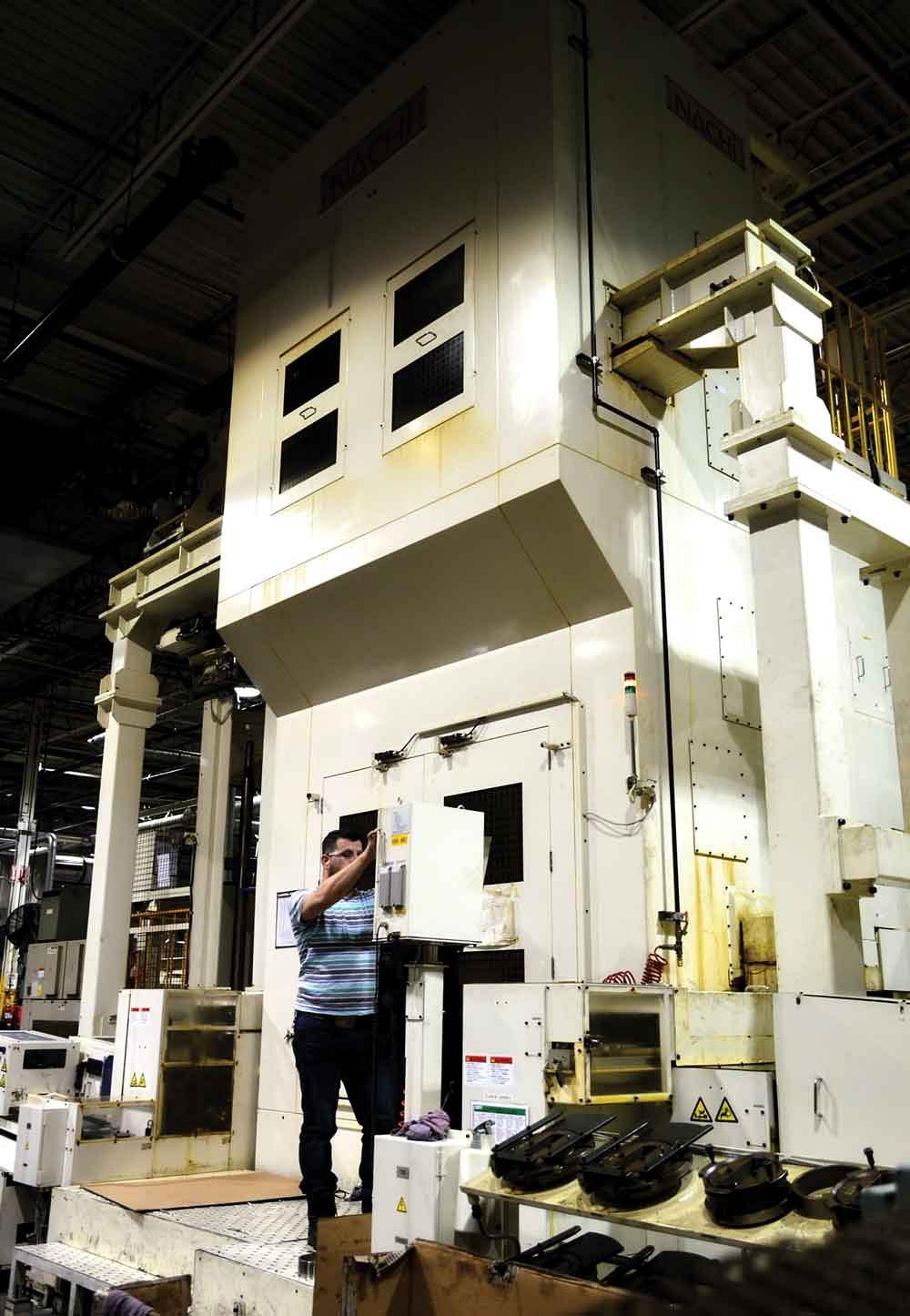- FMA
- The Fabricator
- FABTECH
- Canadian Metalworking
Changing Gears
Linamar Gear Drives up the Numbers
- By Sue Roberts
- August 11, 2016
- Article
- Metalworking

Linamar Gear’s Craig Ferneyhough, general manager, and Ania Kreft, quality manager, pose with transmission parts and assemblies by one of the shop’s robotic welding machines.
Rapidly advancing numbers are the norm at Linamar Corporation, a manufacturer of powertrain components for the automotive, industrial, off-highway, and energy markets and Skyjack™ telehandler equipment. The number of facilities keeps growing.
The company has 57 manufacturing facilities globally and recently opened its new Detroit, Mich.-based McLaren Engineering Tech Center that provides engineering, testing, and prototyping capabilities for automotive OEMs and other Linamar entities.
Consistent double-digit financial growth brought 2015 sales to $5.2 billion. The company currently employs more than 23,000 people. In Guelph, Ont., home of corporate headquarters and 22 facilities, the company’s need for dedicated employees drove area unemployment levels down to 3.9 per cent, about half of the national norm.
It all started 50 years ago when Frank Hasenfratz, a Hungarian immigrant, converted a washing machine into a lathe and set up shop in his basement. Today his daughter Linda has stepped into the CEO position and Frank remains active on the board and pursues cost-cutting and lean initiatives within the manufacturing operations.
The company’s main focus continues to be on machining, but forging and light metal casting have been added to the capabilities mix, and metal forming processes are found in the Skyjack aerial platform equipment plant. In addition to the manufacturing sites, 15 sales offices, six development centres, and four support facilities are located across the globe.
Heat Treat and Gears
Linamar Gear is one of the Guelph manufacturing facilities with its own collection of ever-increasing numbers. The division’s 513 employees produce precision transmission and driveline components and assemblies, including highly complex gears, and keep work flowing through 22 heat-treat furnaces that work around the clock, possibly the largest heat-treat installation under one roof in North America.
The division itself has a strong history of growth. In 2002 it was established to develop Linamar’s gear manufacturing capabilities in 12,400 sq. ft. located in another company facility. By 2005 it moved to its own 80,000-sq.-ft. building to accommodate gear machining and heat treating at one location. Further expansions brought the size of the sprawling facility to 223,000 sq. ft. of manufacturing and office space.
Adept at collecting certifications and awards, Linamar Gear has captured the ISO/Technical Specification 16949 certification, the Q1 Ford certificate, the QSB+ GM designation, and the FCA (Fiat Chrysler Automotive) award for outstanding quality while manufacturing 32 million gears in the past five years. The division provides products to several automotive OEMs as well as to many of the Linamar sister companies.
Heat-treat capabilities include carburizing, through hardening, annealing, normalizing, carbonitriding, quench pressing, induction hardening, deep freezing, and shot peening. Metalworking processes include hobbing, broaching, shaping, grinding, shaving, honing, laser welding and marking, spline rolling, assembly, balancing, polishing, turning, milling, and drilling.
Millions of Components
A batch of less than 100,000 is considered small. For example, last year on its main product lines the plant produced over 350,000 sets of output shafts and input shaft clutch assemblies; nearly 2.5 million sets of drive and driven sprockets; and over 125,000 sets of annulus, sun, and pinion gears. Seven million units are heat-treated annually.
“Traditionally the automotive OEMs outsourced other components but manufactured their own gears,” said Craig Ferneyhough, general manager. “The gears were considered untouchable because they are highly technical, highly complex parts that are integral to the transmission. When Linamar Gear moved to this facility, it was recognized that we have a great synergy with the heat-treat element required for gear manufacturing and precision machining in one location.
“Now we work as a partner with the OEMs, providing gears on a just-in-time basis. For example, we produce about 350,000 output and input shaft sets a year for one OEM customer. That’s 1,450 a day, roughly a finished part per minute.”
Manufacturing a complex gear assembly requires many processes. Ferneyhough listed a few of the operations involved in producing the input shafts that are used in medium-duty pickup truck applications: facing and centering the part; turning; gun and cross-hole drilling; spline rolling; deburring; induction heat treat and tempering of the shaft; shotblasting and cleaning; straightening for any movement that may have occurred during heat treat; hard turning; centerless grinding; groove grinding for seal installation; laser welding; and cleaning and preparation for clutch assembly.

Craig Ferneyhough, Linamar Gear’s general manager, shows a hypoid ring gear that has been carburized and is about to be reheated for the quench pressing operation.
“We select the appropriate size snap ring and measure and verify the clutch travel. A laser mark is added for identification purposes and it will be ready for inspection and shipping directly to the transmission assembly plant,” he said.
Hundreds of Operations
Some components require just a handful of steps, for example, a ring gear requires turning, drilling, and broaching. “The unique thing about the ring gear is that the helical gear is finished in one broach pass.
You have the guide, the broach, and the finishing shell at the end for final sizing. The gear is basically finished once the broach passes through. Operations involve receiving, broaching, washing, drilling, nitrating, and another wash.”
The difficult part of the ring gear operation is maintaining the broach itself. Its exact number of hits is monitored and estimates are maintained for orders expected to require broaching within the next two years.
As Ferneyhough explained, “The broaches have to be handled very carefully. They are reasonably expensive tools, and lead time for a replacement can be 18 to 24 months. They can be sharpened, but the 60-in. tool loses life with each sharpening and it requires downtime.
“If anything happened to the broach, it would have the potential of shutting down two OEMs. And in our business you don’t shut down a customer. We keep a close eye on all our customer volumes so we can manage production scheduling and tool inventory for up to two years out to avoid any out-of-stock situations.”
The Linamar delivery guarantee has led to significant capital investment to ensure on-time delivery and product quality.
“We are very much a high volume facility,” said Ferneyhough. “That’s what we do best. We work to secure the contracts, set up our processes, and run them for their five- to seven-year lifespan.”
The company recently won contracts to provide gears for nine-speed transmission components that are in the future for the Detroit Three. The additional gears are part of the OEMs’ continuous efforts to build transmissions that will be paired with more efficient, smaller engines.
“We went through the RFQ process with an OEM and were invited to do a tech review. The tech review allows us to present ideas or concerns with the design from a manufacturing point of view and to offer ideas to make parts more manufacturable and cut costs. Each year our customers expect us to work more efficiently and reduce costs--usually by about 2 per cent. That reduction comes directly from our bottom line if we don’t continuously improve.
“We presented some thoughts that aligned with the six-speed production and that paved the road for us. That’s where the value chain comes into play. We are a full-service supplier, a partner. We don’t just take a print, quote it, and make it.”
Start to Finish QC
Quality control begins at each operator station. Operators are trained to use Mitutoyo gauging equipment and other tools to measure the parts they are producing.
Ania Kreft, quality manager, said, “We try to involve operators at the very first point of production when parts are being machined. It is more economical and carries less risk to control quality at the source because once a nonconforming component is produced, you have to be able to contain it.
“Operators are trained to take the measurements and enter them into a database at regularly scheduled times. If there is a problem, we see it as soon as possible and can review, analyze, and take the necessary actions to correct it in real time.”
An added advantage to the shop floor quality procedures is operator engagement. “Our operators are proud of the quality of the parts they produce. If we suggest a process is not making a quality part, the operator can turn to his reports and show me that his parts are within specification. It is good for our customers and good for us to have everybody engaged,” Kreft said.
Sample parts move on to the quality lab. Specialized equipment provides the assurance that gears are within specifications. Lab equipment includes Klingelnberg P26 and P40 gear analyzers, Zeiss CMMs, roundness testers, contour and surface tracers, and double and single flank roll testers.
Kreft said, “Our five Klingelnberg analyzers provide us with the information we need to show that the gear is precise and meets the expectations of the customer. We also use roll testers to detect any damage on a gear that our three CMMs or gear analyzers don’t find.
“On the heat-treat side, some of our processes require in-process inspection to ensure parts have achieved the desired hardness and microstructure. Microscopes and microtesters are used for those tests.”
Workforce Gets It Done
Ferneyhough described the company culture as “have fun and get it done.” The company works hard to keep employees happy and closely involved with their work.
“We believe that people should be able to have fun and enjoy each other’s company while they work to deliver the results we need,” he said. “We try to have enough activities to break up the routine of coming to work. We try to pay attention to each employee. You can’t underestimate the impact of a moment’s time or a friendly gesture.” Quarterly lunches, birthday cards, Tim Hortons gift cards, the traditional Christmas party, and celebrations that include everyone when a quality goal such as the Ford Q1 is achieved are part of the activities sponsored by the company.
Other activities have been developed and are coordinated entirely by employees. Ferneyhough’s and Kreft’s favorite is a series of potluck luncheons celebrating the diverse cultures within the workforce population. “About five years ago our employees from the Indian community sponsored the first potluck for the entire plant. They provided the food, decorations, a slide show depicting the culture, and wore traditional dress,” said Kreft.
That caught on and now other groups sponsor similar companywide events to share their own cultures. “We celebrate the Chinese New Year, Diwali, Easter, and Canada Day. We have a Filipino lunch and potlucks with African and Middle East themes. The events are organized, funded, and staffed entirely by employees. It’s a great example of the importance we place on company culture and values such as workplace respect and diversity,” said Ferneyhough.
In addition to workplace camaraderie, Linamar offers educational programs to train new hires and help established employees advance. Training begins with basic education on company, health, and safety policies at the Frank Hasenfratz Centre of Excellence in Manufacturing, and moves on to on-the-job instruction. Courses on topics from blueprint reading to maintenance to finance are also available at the centre. One program, known as “Each 1, Teach 1,” puts high-potential employees in a succession program to train them for the next step in their departments.
Employees with entrepreneurial tendencies can express interest in an educational program available for individuals who are interested in pursuing manufacturing management careers. LEAP, the Linamar Entrepreneurial Advancement Program, is a three- to five-year commitment. Participants spend six months to a year working in various departments, such as finance, materials, production, and sales, to give them a well-rounded perspective on the business and prepare them for leadership roles.
Educating to Promote
Linamar provides an opportunity for everyone to grow and learn. Kreft understands this and encourages her team members to take advantage of the programs. Having come to Canada with little to no English skills, she has managed to secure her own leadership role. She takes pride in overseeing the quality of every component produced at the plant and working with the customers.
“Quality is not just the dimensions of the part,” said Kreft, “it is the customer experience from when we answer the phone through shipping the parts. We have fantastic relationships with our customers. They know that we care and treat us as partners.”
The company focus on education and advancement is apparent. Ferneyhough started with the company as a junior accountant in 1991. As he progressed through the various stages of the financial functions, he became interested in operations. “They gave me an opportunity and here I am,” he said. “I tell people that here you are only limited by your own potential because the company needs quality people. For several years now we’ve had double-digit growth. That results in significant new job opportunities each year and every year.
“As our numbers grow,” he said, “it’s a little more difficult to keep a small-business feel. But we always say think big, act small. Have big goals, but don’t let the bureaucracy and waste of a large organization creep in. It helps us keep the customers happy, hit our financial targets, and keep the workforce happy.”
The Linamar corporatewide slogan for its 50th anniversary year, chosen from employee suggestions, seems right on target: Working together. Succeeding together.
Associate Editor Sue Roberts can be reached at sroberts@canadianmetalworking.com.
Photos courtesy of Linamar Gear, 519-827-9423, www.linamar.com.
About the Author

Sue Roberts
2135 Point Blvd
Elgin, IL 60123
815-227-8241
Sue Roberts, associate editor, contributes to both Canadian Metalworking and Canadian Fabricating & Welding. A metalworking industry veteran, she has contributed to marketing communications efforts and written B2B articles for the metal forming and fabricating, agriculture, food, financial, and regional tourism industries.
Roberts is a Northern Illinois University journalism graduate.
subscribe now


Keep up to date with the latest news, events, and technology for all things metal from our pair of monthly magazines written specifically for Canadian manufacturers!
Start Your Free Subscription- Industry Events
MME Winnipeg
- April 30, 2024
- Winnipeg, ON Canada
CTMA Economic Uncertainty: Helping You Navigate Windsor Seminar
- April 30, 2024
- Windsor, ON Canada
CTMA Economic Uncertainty: Helping You Navigate Kitchener Seminar
- May 2, 2024
- Kitchener, ON Canada
Automate 2024
- May 6 - 9, 2024
- Chicago, IL
ANCA Open House
- May 7 - 8, 2024
- Wixom, MI

























